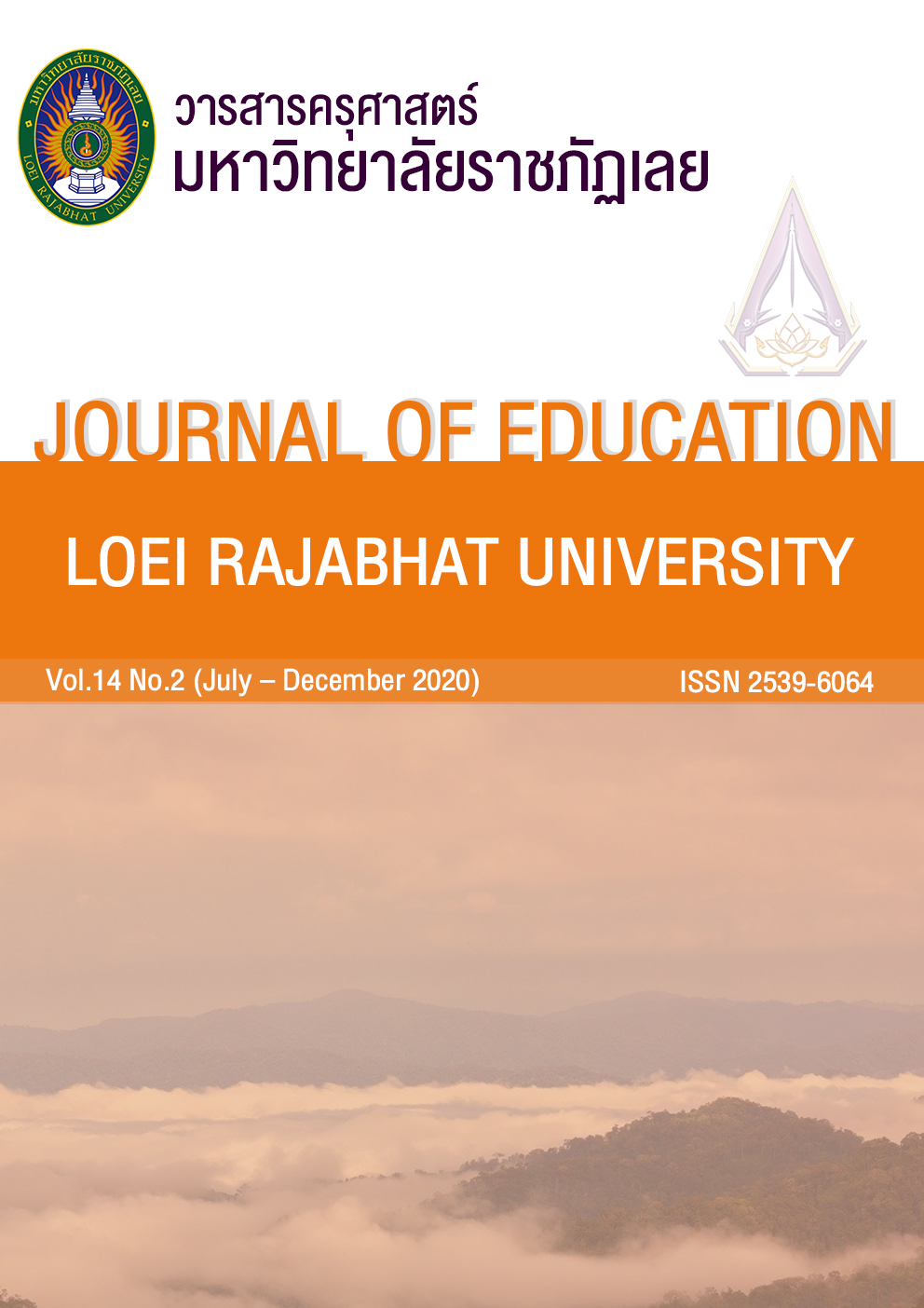ปัจจัยที่ส่งผลต่อยุทธศาสตร์การเรียนรู้ของนักศึกษาคณะครุศาสตร์ มหาวิทยาลัยราชภัฏเลย : การวิเคราะห์พหุระดับ
คำสำคัญ:
ยุทธศาสตร์การเรียนรู้, การวิเคราะห์โมเดลพหุระดับ, บรรยากาศทางการเรียนบทคัดย่อ
การวิจัยนี้มีวัตถุประสงค์เพื่อศึกษาความสัมพันธ์ระหว่างปัจจัยระดับนักศึกษาและปัจจัยระดับห้องเรียนกับยุทธศาสตร์การเรียนรู้ของนักศึกษาคณครุศาสตร์ และเพื่อศึกษาอิทธิพลของปัจจัยระดับนักศึกษาและปัจจัยระดับห้องเรียนที่ส่งผลต่อยุทธศาสตร์การเรียนรู้ของนักศึกษาคณะครุศาสตร์กลุ่มตัวอย่างเป็นนักศึกษาคณะครุศาสตร์ จำนวนนักศึกษา 590 คน 59 ห้องเรียน ได้มาโดยการสุ่มแบบหลายขั้นตอน เครื่องมือที่ใช้ประกอบด้วยแบบสอบถามวัยุทธศาสตร์การเรียนรู้ บรรยากาศทางการเรียน ความเชื่ออำนาจภายในตน เจตคติต่อการเรียน และการกำกับตนเองในการเรียนรู้วิเคราะห์ข้อมูลโมเดลการวิเคราะห์พหุระดับ (Multilevel Analysis) ด้วยเทคนิค HLM (Hierarchical Linear Model) ผลการวิจัยพบว่า
1 ปัจจัยระดับนักศึกษา ได้แก่ ความเชื่ออำนาจภายในตน เจตคติต่อการเรียน และการกำกับตนเองในการเรียนมีความสัมพันธ์กับยุทธศาสตร์การเรียนรู้อย่างมีนัยสำคัญทางสถิติที่ระดับ .01
2 ปัจจัยระดับนักศึกษาที่ส่งผลทางบวกต่อยุทธศาสตร์การเรียนรู้มี 3 ปัจจัย ได้แก่ ความเชื่ออำนาจภายในตน เจตคติต่อการเรียน และการกำกับตนเองในการเรียน โดยร่วมอภิปรายความแปรปรวนของยุทธศาสตร์การเรียนรู้ของนักศึกษาได้ร้อยละ 76.60
3 ปัจจัยระดับห้องเรียน คือ บรรยากาศทางการเรียน มีความสัมพันธ์กับอย่างมีนัยสำคัญทางสถิติที่ระดับ .01
4 ปัจจัยระดับห้องเรียนที่ส่งผลทางบวกต่อยุทธศาสตร์การเรียนรู้คือบรรยากาศทางการเรียนโดยอภิปรายความแปรปรวนของยุทธศาสตร์การเรียนรู้ของนักศึกษาได้ร้อยละ 75.29
เอกสารอ้างอิง
กระทรวงศึกษาธิการ. (2545). เอกสารประกอบหลักสูตรการศึกษาขั้นพื้นฐาน พุทธศักราช 2544 คู่มือจัดการเรียนรู้กลุ่มสาระการเรียนรู้คณิตศาสตร์. กรุงเทพฯ: โรงพิมพ์คุรุสภา.คณะกรรมการการศึกษาแห่งชาติ, สำนักงาน. (2553). พระราชบัญญัติการศึกษาแห่งชาติ (ฉบับที่ 3) พ.ศ.2553. กรุงเทพฯ: สำนักนายกรัฐมนตรี.
ณัฐวรรณ กาบคํา. (2551). การศึกษาปัจจัยบางประการที่ส่งผลต่อยุทธศาสตร์การเรียนรู้ของนักเรียนชั้นมัธยมศึกษาปีที่ 4 สังกัดสำนักงานเขตพื้นที่การศึกษาชัยภูมิ เขต 2. ปริญญานิพนธ์ กศ.ม. (การวิจัยและสถิติทางการศึกษา). กรุงเทพฯ: บัณฑิตวิทยาลัย มหาวิทยาลัยศรีนครินทรวิโรฒ.
ทิวัตถ์ มณีโชติ. (2542). การวิเคราะห์ผลกระทบของโครงการพัฒนาทรัพยากรมนุษย์สังกัดระทรวงศึกษาธิการด้วยวิธีเอชแอลเอ็ม. วิทยานิพนธ์ปริญญาดุษฎีบัณฑิต. ภาควิชาวิจัยการศึกษา คณะครุศาสตร์ จุฬาลงกรณ์มหาวิทยาลัย.
ปวีณรัตน์ มณีวรรณ์. (2548). การศึกษาตัวแปรที่ส่งผลต่อยุทธศาสตร์การเรียนรู้ของนักเรียน ชั้นมัธยมศึกษาปีที่ 3 จังหวัดกาญจนบุรี โดยการวิเคราะห์พหุระดับ. ปริญญานิพนธ์ กศ.ม.(การวิจัยและสถิติทางการศึกษา). กรุงเทพฯ: บัณฑิตวิทยาลัย มหาวิทยาลัยศรีนครินทรวิโรฒ.
ผ่องพรรณ เกิดพิทักษ์ และคมเพชร ฉัตรศุภกุล. (2543). รายงานการวิจัยเรื่อง ยุทธวิธีการเรียนและการศึกษาของนักเรียนวัยรุ่น. กรุงเทพฯ: ภาควิชาการแนะแนวและจิตวิทยาการศึกษา คณะศึกษาศาสตร์มหาวิทยาลัยศรีนครินทรวิโรฒ.
พิไลลักษณ์ อ่อนละมูล. (2546). การศึกษาและการพัฒนายุทธวิธีในการเรียนของนักเรียนชั้นมัธยมศึกษาปีที่ 3 โดยการให้คำปรึกษากลุ่มตามทฤษฎีพฤติกรรมนิยม. ปริญญานิพนธ์ กศ.ม. (จิตวิทยาการแนะแนว). กรุงเทพฯ: บัณฑิตวิทยาลัย มหาวิทยาลัยศรีนครินทรวิโรฒ.
รัศนา จั่นสกุล. (2547). การสังเคราะห์งานวิจัยที่วิเคราะห์ด้วยโมลเดลเชิงเส้นตรงระดับลดหลั่น: การวิเคราะห์อภิมาน. ปริญญานิพนธ์ กศ.ม. (การอุดมศึกษา). กรุงเทพฯ: บัณฑิตวิทยาลัย มหาวิทยาลัยศรีนครินทรวิโรฒ.
วราภรณ์ วิหคโต. (2536). การวิเคราะห์ซ้ำตัวแปรพหุระดับที่มีอิทธิพลต่อผลสัมฤทธิ์ทางการเรียนคณิตศาสตร์ของนักเรียนชั้นมัธยมศึกษาตอนปลาย: การเปรียบเทียบระหว่างเทคนิคโอแอลเอช เซพเพอร์เรท อิเควชั่น กับเทคนิคเอชแอลเอ็ม. วิทยานิพนธ์ ค.ม. (วิจัยการศึกษา). กรุงเทพฯ: บัณฑิตวิทยาลัยจุฬาลงกรณ์มหาวิทยาลัย.
ศิริชัย กาญจนวาสี. (2550). การวิเคราะห์พหุระดับ. (พิมพ์ครั้งที่ 4). กรุงเทพมหานคร: โรงพิมพ์แห่งจุฬาลงกรณ์มหาวิทยาลัย.
สุพรรณี สินโพธิ์. (2546). ปัจจัยที่มีอิทธิพลต่อสมรรถภาพการวิจัยเชิงปฏิบัติการในชั้นเรียนของครูประถมศึกษาโดยใช้การวิเคราะห์โมเดลเชิงเส้นตรงระดับลดหลั่น. วิทยานิพนธ์ ค.ม. (วิจัยการศึกษา). กรุงเทพฯ: บัณฑิตวิทยาลัย จุฬาลงกรณ์มหาวิทยาลัย.
Cambell, Kathryn Kawai. (1996, October). A Study of Selected Characteristics and Learning Strategies of students Related to Persistence in Telecourses. Dissertation Abstracts International. 57(04): 1405.
Chacko, Sandra Beermann. (1989). Cognitive abilities, affective characteristics and learning strategies as related to academic achievement among first-year nursing student: Test Validation and Causal Medeling. (Online). Available: WWW.lib.um.com; Directory: dissertation/fullcit/9014888. Retrieved January, 5, 2004.
Freedman, Marcia. (1996, July). Self- Efficacy and Learning and Learning Strategy Use in A Computer-Based in Structional Setting. Dissertation Abstracts International. 57(01): 99.
Lindgren, Clay Henry. (1969). The Psychology of College Success: A Dynamic Approach. New York: John Wiley and sons, Inc.,
Maddox, Harry. (1965). How to study. London : The English Language Book Society.
Mehrens, William. A.; and Lehman J. Irvin. (1975). Measurement and Evaluation in Education and Psychology. 2 nd ed. New York: Holt, Rinehart and Winston, Inc.
Motz, Mary M. (1996). Relationship Between Students Epistemological Beliefs and Learning Strategies Use. Master Abstracts International. 34/06, p. 2127, December. Moursund. 1976
Nam Jung, Yung Suk. (1996). Cultural and Contextual Influences on Goal Orientations and the Relationships among Goal Orientations, Learning Strategies and Achievement: A Study of Korean High School students Learning English. Dissertation Abstracts International. 57/06, p. 2345, December.
Nisbet, John; & Shucksmit, Janet. (1986). Learning Strategies. New York: Chapman and Hall.
Rogers, Carl. (1969). Freedom to Learn. Columbus, Ohio: Charies E. Merrill.
Rowntree, Derek. (1981). A Dictionary of Education. London: Harper and row.
Weinstein, Claire E.;& Mayer, R.E. (1986). The Teaching of Learning Strategies. In M.C.Wittrock, Handbook of Research on Teaching. 3 rd ed. New York: Macmillan.
ดาวน์โหลด
เผยแพร่แล้ว
รูปแบบการอ้างอิง
ฉบับ
ประเภทบทความ
สัญญาอนุญาต

อนุญาตภายใต้เงื่อนไข Creative Commons Attribution-NonCommercial-NoDerivatives 4.0 International License.
เนื้อหาและข้อมูลในบทความที่ตีพิมพ์ในวารสารครุศาสตร์ มหาวิทยาลัยราชภัฏเลย ถือเป็นความคิดเห็นและความรับผิดชอบของผู้เขียนบทความโดยตรง กองบรรณาธิการวารสารไม่มีส่วนในความคิดเห็นและความรับผิดชอบใดที่เกี่ยวข้องกับบทความดังกล่าว ทั้งนี้ บทความที่ได้รับการตีพิมพ์ในวารสาร ฯ ถือเป็นลิขสิทธิ์ของวารสาร







